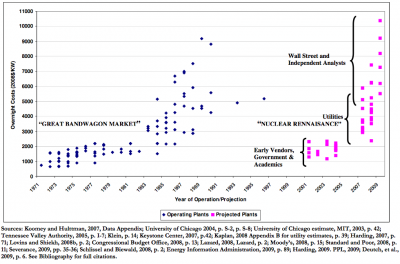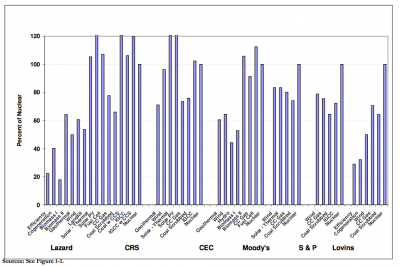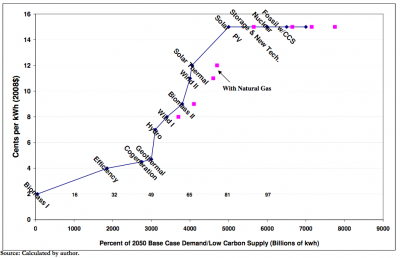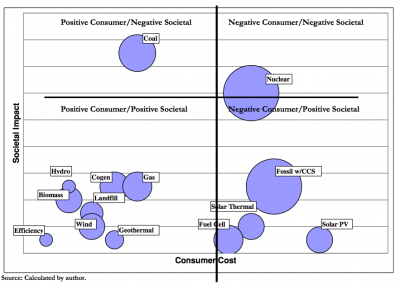The Economics of Nuclear Reactors: Renaissance or Relapse?
Posted by Mark Cooper in Unsustainable 1 Comment» Within the past year, estimates of the cost of nuclear power from a new generation of reactors have ranged from a low of 8.4 cents per kilowatt hour (kWh) to a high of 30 cents. This paper tackles the debate over the cost of building new nuclear reactors. The most recent cost projections for new nuclear reactors are, on average, over four times as high as the initial “nuclear renaissance” projections. The additional cost of building 100 new nuclear reactors, instead of pursuing a least cost efficiency-renewable strategy, would be in the range of $1.9-$4.4 trillion over the life the reactors.
Within the past year, estimates of the cost of nuclear power from a new generation of reactors have ranged from a low of 8.4 cents per kilowatt hour (kWh) to a high of 30 cents. This paper tackles the debate over the cost of building new nuclear reactors. The most recent cost projections for new nuclear reactors are, on average, over four times as high as the initial “nuclear renaissance” projections. The additional cost of building 100 new nuclear reactors, instead of pursuing a least cost efficiency-renewable strategy, would be in the range of $1.9-$4.4 trillion over the life the reactors.
The key findings of the paper as follows:
- The initial cost projections put out early in today’s so-called “nuclear renaissance” were about one-third of what one would have expected, based on the nuclear reactors completed in the 1990s.
- The most recent cost projections for new nuclear reactors are, on average, over four times as high as the initial “nuclear renaissance” projections.
- There are numerous options available to meet the need for electricity in a carbon-constrained environment that are superior to building nuclear reactors. Indeed, nuclear reactors are the worst option from the point of view of the consumer and society.
- The low carbon sources that are less costly than nuclear include efficiency, cogeneration, biomass, geothermal, wind, solar thermal and natural gas. Solar photovoltaics that are presently more costly than nuclear reactors are projected to decline dramatically in price in the next decade. Fossil fuels with carbon capture and storage, which are not presently available, are projected to be somewhat more costly than nuclear reactors.
- Numerous studies by Wall Street and independent energy analysts estimate efficiency and renewable costs at an average of 6 cents per kilowatt hour, while the cost of electricity from nuclear reactors is estimated in the range of 12 to 20 cents per kWh.
- The additional cost of building 100 new nuclear reactors, instead of pursuing a least cost efficiency-renewable strategy, would be in the range of $1.9-$4.4 trillion over the life the reactors.
Whether the burden falls on ratepayers (in electricity bills) or taxpayers (in large subsidies), incurring excess costs of that magnitude would be a substantial burden on the national economy and add immensely to the cost of electricity and the cost of reducing carbon emissions.
Approach
This paper arrives at these conclusions by viewing the cost of nuclear reactors through four analytic lenses.
- First, in an effort to pin down the likely cost of new nuclear reactors, the paper dissects three dozen recent cost projections.
- Second, it places those projections in the context of the history of the nuclear industry with a database of the costs of 100 reactors built in the U.S. between 1971 and 1996.
- Third, it examines those costs in comparison to the cost of alternatives available today to meet the need for electricity.
- Fourth, it considers a range of qualitative factors including environmental concerns, risks and subsidies that affect decisions about which technologies to utilize in an environment in which public policy requires constraints on carbon emissions.
The stakes for consumers and the nation are huge. While some have called for the construction of 200 to 300 new nuclear reactors over the next 40 years, the much more modest task of building 100 reactors, which has been proposed by some policymakers as a goal, is used to put the stakes in perspective. Over the expected forty-year life of a nuclear reactor, the excess cost compared to least-cost efficiency and renewables would range from $19 billion to $44 billion per plant, with the total for 100 reactors reaching the range of $1.9 trillion to $4.4 trillion over the life the reactors.
Hope and Hype Vs. Reality in Nuclear Reactor Costs
From the first fixed price turnkey reactors in the 1960s to the May 2009 cost projection of the Massachusetts Institute of Technology, the claim that nuclear power is or could be cost competitive with alternative technologies for generating electricity has been based on hope and hype. In the 1960s and 1970s, the hope and hype analyses prepared by reactor vendors and parroted by government officials helped to create what came to be known as the “great bandwagon market.” In about a decade utilities ordered over 200 nuclear reactors of increasing size.
Unfortunately, reality did not deliver on the hope and the hype. Half of the reactors ordered in the 1960s and 1970s were cancelled, with abandoned costs in the tens of billions of dollars. Those reactors that were completed suffered dramatic cost overruns (see Figure ES-1). On average, the final cohort of great bandwagon market reactors cost seven times as much as the cost projection for the first reactor of the great bandwagon market. The great bandwagon market ended in fierce debates in the press and regulatory proceedings throughout the 1980s and 1990s over how such a huge mistake could have been made and who should pay for it.
In an eerie parallel to the great bandwagon market, a series of startlingly low-cost estimates prepared between 2001 and 2004 by vendors and academics and supported by government officials helped to create what has come to be known as the “nuclear renaissance.” However, reflecting the poor track record of the nuclear industry in the U.S., the debate over the economics of the nuclear renaissance is being carried out before substantial sums of money are spent. Unlike the 1960s and 1970s, when the utility industry, reactor vendors and government officials monopolized the preparation of cost analyses, today Wall Street and independent energy analysts have come forward with much higher estimates of the cost of nuclear reactors.

Figure ES-1: Overnight Cost of Completed Nuclear Reactors Compared to Projected Costs of Future Reactors
The most recent cost projections are, on average, over four times as high as the initial nuclear renaissance projections.
Even though the early estimates have been subsequently revised upward in the past year and utilities offered some estimates in regulatory proceedings that were twice as high as the initial projections, these estimates remain well below the projections from Wall Street and independent analysts. Moreover, in an ominous repeat of history, utilities are insisting on cost-plus treatment of their reactor projects and have steadfastly refused to shoulder the responsibility for cost overruns.
One thing that utilities and Wall Street analysts agree on is that nuclear reactors will not be built without massive direct subsidies either from the federal government or ratepayers, or from both.
In this sense, nuclear reactors remain as uneconomic today as they were in the 1980s when so many were cancelled or abandoned.
The Economic Cost of Low Carbon Alternatives
There is a second major difference between the debate today and the debate in the 1970s and 1980s. In the earlier debate, the competition was almost entirely between coal and nuclear power generation. Today, because the debate is being carried out in the context of policies to address climate change, a much wider array of alternatives is on the table. While future fossil fuel (coal and natural gas) plants with additional carbon capture and storage technologies that are not yet available are projected to be somewhat more costly than nuclear reactors (see Figure ES-2), efficiency and renewables are also primary competitors and their costs are projected to be much lower than nuclear reactors.

Figure ES-2: Busbar Costs of Alternatives by Estimating Entity (Nuclear Reactor Cost = 100 Percent)
Figure ES-2 presents the results of half a dozen recent studies of the cost of alternatives, including two by government entities, three by Wall Street analysts and one by an independent analyst. Figure ES-2 expresses the cost estimated by each study for each technology as a percentage of the study’s nuclear cost estimate. Every author identifies a number of alternatives that are less costly than nuclear reactors.
One of the central concerns about reliance on efficiency and renewables to meet future electricity needs is that they may not be available in sufficient supply. However, analysis of the technical potential to deliver economically practicable options for low-cost, low-carbon approaches indicates that the supply is ample to meet both electricity needs and carbon reduction targets for three decades or more based on efficiency, renewables and natural gas (see Figure ES-3).

Figure ES-3: Meeting Electricity Needs in a Carbon Constrained Environment (Cost of Alternatives Substitution Curve)
Figure ES-3 builds a “supply curve” of the potential contribution and cost of efficiency and renewables, based on analyses by the Rand Corporation, McKinsey and Company, the National Renewable Energy Laboratory, the Union of Concerned Scientists and the American Council for an Energy Efficient Economy. Clearly, there is huge potential for low carbon approaches to meet electricity needs. To put this potential into perspective, long-term targets call for emissions reductions below 2005 levels of slightly more than 40 percent by 2030 and 80 percent by 2050. Even assuming that all existing low carbon sources (about 30 percent of the current mix) have to be replaced by 2030, there is more than ample potential in the efficiency and renewables.
With continuing demand growth, it would still not be until 2040 that costly or as yet nonexistent technologies would be needed. Thus, pursuing these low cost options first meets the need for electricity and emissions reductions, while allowing time for technologies to be developed, such as electricity storage or carbon capture, that could meet electricity needs after 2040. The contending technologies that would have to be included in the long term are all shown with equal costs, above the technologies that have lower costs because it is difficult to project costs that far out in future and there will likely be a great deal of technological change before those technologies must be tapped to add substantial incremental supplies.
A Comprehensive View of Options for Meeting Electricity Needs
In addition to their cost, nuclear reactors possess two other characteristics that make them an inferior choice among the options available.
- The high capital costs and long construction lead times associated with nuclear reactors make them a risky source of electricity, vulnerable to market, financial, and technological change that strengthen the economic case against them.
- While nuclear power is a low carbon source of electricity, it is not an environmentally benign source. The uranium fuel cycle has significant safety, security, and waste issues that are far more damaging than the environmental impact of efficiency and renewables.
Figure ES-4 depicts three critical characteristics of the alternatives available for meeting electricity needs in a carbon-constrained environment. The horizontal axis represents the economic cost. The vertical axis represents the societal cost (with societal cost including environmental, safety, and security concerns). The size of the circles represents the risk. Public policy should exploit the options closest to the origin, as these are the least-cost alternatives. Where the alternatives are equal on economic cost and societal impact, the less risky should be pursued.

Figure ES-4: A Multi-dimensional View of Alternatives (Size of Circles Denotes Risk)
Nuclear reactors are shown straddling the positive/negative line on societal impact. If the uranium production cycle – mining, processing, use and waste disposal – were deemed to have a major societal impact, nuclear reactors would be moved much higher on the societal impact dimension. If one believes that nuclear reactors have a minor impact, reactors would be moved down on the societal impact dimension. In either case, there are numerous options that should be pursued first. Thus, viewed from a multidimensional perspective, including economic, environmental, and risk factors, there are numerous preferable alternatives.
The Impact of Subsidies
As noted, nuclear reactors are very unlikely to be built without ratepayer and taxpayer subsidies. Many of the hope and hype analyses advance scenarios in which carbon is priced and nuclear reactors are the beneficiaries of large subsidies. Under those sets of extreme assumptions, nuclear reactors become less costly than fossil fuels with carbon capture and storage costs. However, they do not become less costly than efficiency and renewables. High carbon costs make efficiency and renewables more attractive.
Moreover, public policy has not tended to be quite so biased, although the supporters of nuclear power would like it to be. Imposing a price on carbon makes all low carbon options, including efficiency and renewables, more attractive as options.
Subsidy programs tend to be applied to all low carbon technologies. As a result, although the carbon pricing and subsidy programs implemented and contemplated in recent years tend to impose cost on consumers or shift them from ratepayers to taxpayers; they do not change the order in which options enter the mix. In other words, given pricing and subsidies that simply values carbon emission or its abatement, the economic costs as estimated above dictate the order in which options are implemented. Nuclear reactors remain the worst option. It is possible to bias policies so severely that the order of priority changes, but that simply imposes unnecessary costs on consumers, taxpayers, and society.
Conclusion
The highly touted renaissance of nuclear power is based on fiction, not fact. It got a significant part of its momentum in the early 2000s with a series of cost projections that vastly understated the direct costs of nuclear reactors. As those early cost estimates fell by the wayside and the extremely high direct costs of nuclear reactors became apparent, advocates for nuclear power turned to climate change as the rationale to offset the high cost. But introducing environmental externalities does not resuscitate the nuclear option for two reasons. First, consideration of externalities improves the prospects of non-fossil, non-nuclear options to respond to climate change. Second, introducing externalities so prominently into the analysis highlights nuclear power’s own environmental problems. Even with climate change policy looming, nuclear power cannot stand on its own two feet in the marketplace, so its advocates are forced to seek to prop it up by shifting costs and risks to ratepayers and taxpayers.
The aspiration of the nuclear enthusiasts, embodied in early reports from academic institutions, like MIT, has become desperation, in the updated MIT report, precisely because their reactor cost numbers do not comport with reality. Notwithstanding their hope and hype, nuclear reactors are not economically competitive and would require massive subsidies to force them into the supply mix. It was only by ignoring the full range of alternatives — above all efficiency and renewables — that the MIT studies could pretend to see an economic future for nuclear reactors, but the analytic environment has changed from the early days of the great bandwagon market, so that it is much more difficult to get away with passing off hope and hype as reality.
The massive shift of costs necessary to render nuclear barely competitive with the most expensive alternatives and the huge amount of leverage (figurative and literal) that is necessary to make nuclear power palatable to Wall Street and less onerous on ratepayers is simply not worth it because the burden falls on taxpayers. Policymakers, regulators, and the public should turn their attention to and put their resources behind the lower-cost, more environmentally benign alternatives that are available. If nuclear power’s time ever comes, it will be far in the future, after the potential of the superior alternatives available today has been exhausted.
More information
- The full paper: The Economics of Nuclear Reactors: Renaissance or Relapse?
Mark Cooper, Senior Fellow for Economic Analysis Institute for Energy and the Environment Vermont Law School





1 reply on “The Economics of Nuclear Reactors: Renaissance or Relapse?”
An eye opener.
I must read the complete article “The Economics of Nuclear Reactors: Renaissance or Relapse?”. A little bit of topic; what about the Thorium promise? A few year’s ago, it would be a matter of time to start up this next generation cheap fuell reactors. May be I missed something, but I think that this solution needs a little bit more time and -wasted- money…..